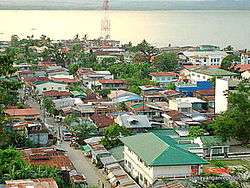Guinayangan
| Guinayangan, Quezon | ||
|---|---|---|
| Municipality | ||
 | ||
| ||
 Map of Quezon showing the location of Guinayangan | ||
.svg.png) Guinayangan, Quezon Location within the Philippines | ||
| Coordinates: 13°54′N 122°27′E / 13.900°N 122.450°ECoordinates: 13°54′N 122°27′E / 13.900°N 122.450°E | ||
| Country | Philippines | |
| Region | CALABARZON (Region IV-A) | |
| Province | Quezon | |
| District | 4th district of Quezon | |
| Founded | June 21, 1845 | |
| Barangays | 54 | |
| Government[1] | ||
| • Mayor | Cezar Juarez Isaac III | |
| Area[2] | ||
| • Total | 214.12 km2 (82.67 sq mi) | |
| Population (2015)[3] | ||
| • Total | 45,155 | |
| • Density | 210/km2 (550/sq mi) | |
| Demonym(s) | Guinayanganin | |
| Time zone | PST (UTC+8) | |
| ZIP code | 4319 | |
| Dialing code | 42 | |
| Income class | 3rd class; partially urban | |
| Website |
www | |
Guinayangan is a third class municipality in the province of Quezon, Philippines. According to the 2015 census, it has a population of 45,155 people.[3]
Guinayangan came from a native word for cane "gayang", they "copied"---ginaya and adopted the name to become "ginayangan" or what is now known as "Guinayangan". Its people pronounce it "Ginyangan" omitting the "a" sound.
The municipality is home to the Maulawin Spring Protected Landscape.
Barangays
Guinayangan is politically subdivided into 54 barangays.[2]
- A. Mabini
- Aloneros
- Arbismen
- Bagong Silang
- Balinarin
- Bukal Maligaya
- Cabibihan
- Cabong Norte
- Cabong Sur
- Calimpak
- Capuluan Central
- Capuluan Tulon
- Dancalan Caimawan
- Dancalan Central
- Danlagan Batis
- Danlagan Cabayao
- Danlagan Central
- Danlagan Reserva
- Del Rosario
- Dungawan Central
- Dungawan Paalyunan
- Dungawan Pantay
- Ermita
- Gapas
- Himbubulo Este
- Himbubulo Weste
- Hinabaan
- Ligpit Bantayan
- Lubigan
- Magallanes
- Magsaysay
- Manggagawa
- Manggalang
- Manlayo
- Poblacion
- Salacan
- San Antonio
- San Isidro
- San Jose
- San Lorenzo
- San Luis I
- San Luis II
- San Miguel
- San Pedro I
- San Pedro II
- San Roque
- Santa Cruz
- Santa Maria
- Santa Teresita
- Sintones
- Sisi
- Tikay
- Triumpo
- Villa Hiwasayan
Demographics
| Population census of Guinayangan | ||
|---|---|---|
| Year | Pop. | ±% p.a. |
| 1990 | 32,829 | — |
| 1995 | 36,775 | +2.15% |
| 2000 | 37,164 | +0.23% |
| 2007 | 39,074 | +0.69% |
| 2010 | 41,669 | +2.37% |
| 2015 | 45,155 | +1.54% |
| Source: Philippine Statistics Office[3] | ||
Fiesta
When the month of June comes, the people of Guinayangan, Quezon prepare for the annual celebration of Gayang Festival, wherein the coconut tree and the banana is the main attraction of the festivities. The festival is highlighted by a street dancing competition participated by the residents of different barangays, as well as by elementary and high school students.
In the later part of 2000, the very first Seafoods Festival was held in the town. However, it was replaced by Gayang Festival in the succeeding years to give importance to the town's history.
Schools
High schools:
- Dungawan NHS
- Guinayangan Academy
- Guinayangan NHS
- Guinayangan NHS Extension - Sta. Cruz
- Lamon Bay SOF - Ext. (Aloneros, Guinayangan)
- Nabangka NHS
- Aloneros National High School
- Saint Aloysius Gonzaga Parochial HS
Colleges:
- Guinayangan Institute Of Technology (Permanently Closed)
- G-sisters Learning Institute of Technology (Temporarily Closed)
- Guinayangan College Foundation Inc. GCFI
References
- ↑ "Official City/Municipal 2013 Election Results". Intramuros, Manila, Philippines: Commission on Elections (COMELEC). 11 September 2013. Retrieved 27 November 2013.
- 1 2 "Province: QUEZON". PSGC Interactive. Makati City, Philippines: National Statistical Coordination Board. Retrieved 27 November 2013.
- 1 2 3 "Highlights of the Philippine Population 2015 Census of Population". 2015 Census of Population and Housing. Philippine Statistics Office. Retrieved 26 May 2016.
External links
| Wikimedia Commons has media related to Guinayangan. |
- Philippine Standard Geographic Code
- Philippine Census Information
- Local Governance Performance Management System
 |
Santa Elena, Camarines Norte |  | ||
| Calauag | |
Tagkawayan Ragay Gulf | ||
| ||||
| | ||||
| Lopez | Buenavista |
